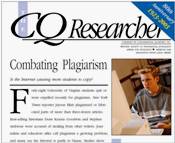 Do you understand plagiarism? Why is it such a big hairy deal anyway? Well, it’s only right and fair to be credited for your own work while giving others proper credit for their work. It’s also important beyond your student years–see the CQ Researcher “Combating Plagiarism” issue from Sept. 19, 2003, that talks about reporters, musicians, and historians getting into hot water for claiming others’ words and ideas. And it’s not just words and ideas, but also images and sources of factual information that need to be cited. Basically, to do otherwise is intellectual theft, behavior both dishonest and unethical. Oh, and you can suffer consequences for plagiarism at UWW (see the Student Handbook‘s section on UW System Policies and specifically UWS Chapter 14.03 “Academic misconduct subject to disciplinary action”).
Do you understand plagiarism? Why is it such a big hairy deal anyway? Well, it’s only right and fair to be credited for your own work while giving others proper credit for their work. It’s also important beyond your student years–see the CQ Researcher “Combating Plagiarism” issue from Sept. 19, 2003, that talks about reporters, musicians, and historians getting into hot water for claiming others’ words and ideas. And it’s not just words and ideas, but also images and sources of factual information that need to be cited. Basically, to do otherwise is intellectual theft, behavior both dishonest and unethical. Oh, and you can suffer consequences for plagiarism at UWW (see the Student Handbook‘s section on UW System Policies and specifically UWS Chapter 14.03 “Academic misconduct subject to disciplinary action”).
So, do you know what to do, or do you need some help understanding how to avoid plagiarism? What’s considered common knowledge? Is everything online fair game? Is anything in an encyclopedia “common knowledge” that doesn’t need to be cited? If you change the wording, do you still need to cite the source? If an image is of a really, really old painting, is it ok to just paste it into your presentation? Not so sure? You aren’t alone! Students at universities and colleges all over have the same uncertainties. Here are some tutorials and videos developed at other academic institutions that may help:
- Rutgers University Libraries developed some videos, including a 5-item quiz you can take online (The videos are actually entertaining): The Anti Plagiarism Game Show Cite is Right! (At the bottom of the screen you can see the links to the other videos in the series.) These are available via YouTube too.
- Indiana University Bloomington’s School of Education provides an online tutorial “How to recognize Plagiarism,” with both a test and a 5-minute quiz.
- The University of Texas Libraries, University of Texas at Austin, have a series of online questions to see how well you understand plagiarism and how to avoid it.
- Lycoming College’s Snowden Library provides a “Goblin Threat” plagiarism game to teach students about recognizing plagiarism, which was “created by Mary Broussard with assistance on question writing from Jessica Urich.” Killing each goblin requires the correct answer to a plagiarism-related question.
- University Libraries at The University of Southern Mississippi offers a plagiarism tutorial with a pre- and post-test.
You can find many other similar sites by searching Google. Ask a librarian for assistance.
